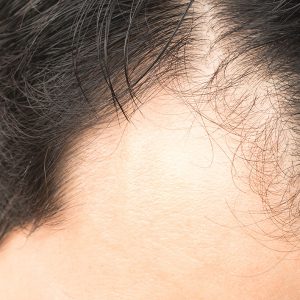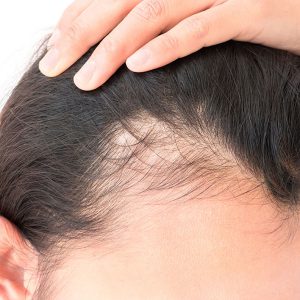Hair Loss Treatment
Hair growth abnormalities include disorders of hair loss, termed alopecia, and excess hair growth known as Hypertrichosis.
Dr. Norris is a hair loss dermatologist specializing in and providing hair loss treatment for both men and women. Abnormalities of hair growth carry a great psychosocial impact, and are intimately related to self-image for both men and women in Portland. Although associations with systemic disease are less common, evaluation, management, and treatment of hair loss disorders are an essential part of patient care within dermatology. Hair growth abnormalities include disorders of hair loss, termed alopecia, and excess hair growth known as Hypertrichosis.
Hair Loss Treatment
Most forms of hair loss have no cure. Some types of hair loss disappear without treatment. Hair loss treatment may include:
- Topical medications to promote hair growth include Minoxidil (Rogaine). This medication works for both men and women in reversing Androgenetic hair loss.
- Finasteride is useful to treat male pattern hair loss. It was not found to be effective in the treatment of post-menopausal hair loss.
- Hair transplants
- Corticosteroid injections – when treating alopecia areata
- Treating any underlying condition or disease (such as low iron or thyroid)
How to Perform a Proper Hair Count
The average person sheds (loses) between 50-100 hairs daily. This amount of loss is not especially noticeable, unless more than the average number is being lost. Sometimes an individual will become more aware of normal loss because of special concerns. To better evaluate your hair loss, it is helpful to have more specific information regarding the numbers of hairs actually shed each day. The following procedure is designed to help you get an accurate count.
- Pick three consecutive days. If you do not shampoo every day, the shampoo day should be the second day.
- The objective of a hair count is to have daily totals of hair loss. Start the count in the morning by removing any existing hairs from your brush, comb, counter, shower, etc. We want to be sure you are counting hairs shed in the current day only. Count any hairs found during the course of your day. This includes your hairbrush, comb, cloths, floor, shower or bathtub (see #3), etc. We are looking for an approximate number. We do not expect you to find every hair.
- We have provided you with a 4×4 inch gauze pad to unfold and place over the drain. This will allow you to trap and collect hairs lost during shower and/or shampooing. Count any hair collected in your gauze and add this to your daily total. More hair is shed during shampooing than with any other common procedure because the hair is subject to more manipulation.
- Again, do this for three consecutive days. We need only the three daily counts. Do not bring the hair with you to the follow-up visit. Count the hairs yourself and throw them away unless otherwise instructed by your physician. You may use this form to record your daily totals.
- Three days is sufficient to obtain an average. Further days are unnecessary, time consuming, and nerve-wracking. Thank you for helping us assess your hair loss concerns. If you have any questions, please do not hesitate to call.
NAME: __________________________________START DATE: _________
Day 1 Total______________Did you shampoo today? YES NO
Day 2 Total______________Did you shampoo today? YES NO
Day 3 Total______________Did you shampoo today? YES NO
Hypertrichosis – Excessive Hair Growth
Hypertrichosis is a term for excessive hair. It may also be localized or diffuse, and may be congenital (present at birth) or acquired at any time. An important form of Hypertrichosis, known as hirsutism, occurs in women and refers to excess hair growth on the body in a male distribution. In some cases this is a normal variant with a genetic predisposition. For many patients, however, this may be a clue to an underlying endocrine disturbance for which treatment may improve the appearance of hirsutism. Hair removal lasers available in Portland are very helpful in reducing excess hair.
You can learn more about hair loss treatment at American Academy of Dermatology.





